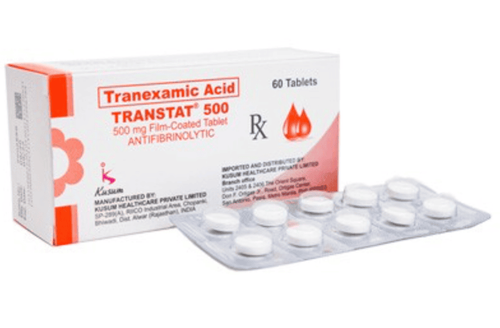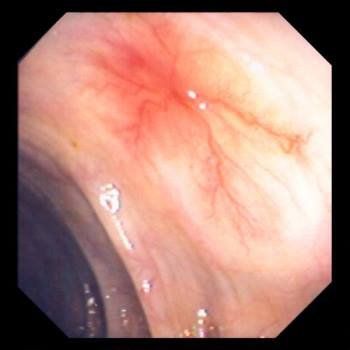This is an automatically translated article.
What is Tranmix? Tranmix 5% is used to treat and prevent bleeding associated with increased fibrinolysis and hereditary angioedema. There have been many articles about this drug line, but not all of them are complete and detailed. The following article would like to send readers the most useful and detailed information about Tranmix 5% drug.
1. Uses of Tranmix 5%
Tranmix 5% drug is indicated for use in the following cases:
Treatment in cases of fibrinolysis, polymenorrhea, nosebleeds, abnormal bleeding due to accidents, injuries, complications in production gynecological and in some surgeries such as bladder surgery, prostate removal in men. Treatment of easy disease and hemophilia in dental surgery, prevention of hereditary symptoms of neuro-angioedema. Do not use Tranmix 5% drug in the following cases:
Hypersensitivity to any ingredient of the drug. Subarachnoid bleeding. The patient has a history of thromboembolism. The patient is suffering from intravascular coagulation. The patient has a disability with color vision
2. Dosage and usage of Tranmix 5%
Tranmix 5% drug is only used by way: Intravenous injection, intravenous infusion. Dosage of Tranmix 5% is used differently for each different group of subjects, specifically:
For adults: The recommended dose is from 500 mg to 1,000 mg or a dose of 10 mg/kg body weight, injected intravenously. IV slowly at a rate of about 100 mg/min, 2 to 3 times/day. For cases of systemic fibrinolysis, a dose of 1,000 mg is given by slow intravenous injection, 3 to 4 times a day. In fibrinolytic syndrome (fibrinolysis is associated with diagnosed intravascular hypercoagulability), an anticoagulant such as heparin can be safely used. For hereditary neuro-angioedema, the recommended dose should be 500 mg to 1,000 mg, administered slowly intravenously at about 100 mg/min or over a period of 5 to 10 minutes, 3 times a day. . When the patient has been on treatment for more than 3 days, oral medication should be considered. Treatment in nosebleeds: Tranexamic acid injection is used by local aerosol method in the nasal mucosa or using a gauze soaked in drug solution to insert into the nasal cavity. In bladder surgery and prostatectomy: The dose for the first 3 days after surgery ranges from 500 mg to 1,000 mg, administered 3 times a day, by slow intravenous injection. Starting on the 4th day after surgery until the urethral blood is no longer flowing, take the drug orally as prescribed by the doctor depending on the patient's condition. In addition, Tranmix 5% can also be used to flush the bladder after surgery. The method is to mix 1 gram of Tranexamic Acid in 1 liter of 0.9% Sodium Chloride washing solution, infuse directly into the bladder at the rate of 1 mL/min, once a day and for 2 to 5 days. post-surgery.
In case of bleeding after dental surgery on the background of patients with hemophilia: Before surgery, a dose of 10 mg/kg body weight is given intravenously. After surgery used orally, the dose is 25mg/kg body weight, used 3-4 times/day and within 2 to 10 days. For children can be used intravenously at a dose of 10mg/kg body weight, usually 2 to 3 times/day. It should be considered that only when adequate oral doses are difficult to administer should the intravenous route be selected. Patients with impaired renal function: Dosage depends on serum creatinine. Creatinine from 120 to 250, intravenous dose: 10 mg/kg body weight, 2 times/day. Creatinine from 250 - 500, intravenous dose: 10 mg/kg body weight, 1 time/day. Creatinine over 500, intravenous dose: 10 mg/kg body weight for 48 hours or 5 mg/kg body weight for 24 hours. In intravenous infusion, Tranmix 5% injection solution can be mixed with most infusion solutions such as: Glucose 5% solution, 0.9% NaCl saline solution, Amino acid solution, Dextran 70 solution. , Dextran 40 solution and Ringer electrolyte solution.
3. Interaction of Tranmix 5% drug
The interaction between drugs and drugs is quite complicated because each drug contains different ingredients. Therefore, patients should not arbitrarily combine Tranmix 5% with other drugs without the indications and instructions of doctors and professionals. It should be noted when combining Tranmix 5% with some of the following drugs:
Tranexamic Acid should not be mixed into solutions containing Penicillin. Tranexamic Acid should not be mixed into the blood for transfusion. Care should be taken when using Tranmix 5% with a group of drugs with hemostatic effects in patients receiving anti-fibrinolytic therapy: when these two groups are combined with high doses, it may cause thrombosis.
4. What are the possible side effects when using Tranmix 5%?
Here are some unwanted effects that may occur when using Tranmix 5%:
Digestive system disorders: Nausea, vomiting, diarrhea, these symptoms usually go away when the patient is sick. dose reduction. Skin sensitization: This condition has been reported clinically but is very rare. Lowering blood pressure, dizziness can occur when administered intravenously at a rapid rate, so it is recommended to inject Tranmix 5% at a rate of less than 100 mg/min.
5. What precautions should be taken when using Tranmix 5%?
Note the careful use of Tranmix 5% drug in some cases:
Patients with impaired kidney function: when using the drug for this group of subjects, there is a risk of drug accumulation. The patient is experiencing urinary tract bleeding. Patients are at risk of thrombosis. In animal clinical trials, Tranexamic Acid caused focal areas of retinal degeneration and visual disturbances. Although there have been no reports on the effects of this drug on human eye organs, it is recommended that patients taking this drug for a long time should have an ophthalmologic examination with tests of visual acuity, color vision, and fundus. eye, visual field of the eye before and after treatment with periodic courses of medication. Tranexamic acid crosses the placenta and is absorbed from mother to child. It has been reported that mothers who take Tranexamic Acid during pregnancy to treat fibrinolysis or obstetric-related bleeding give birth to healthy babies. However, there are no adequate and well-controlled studies in humans, so it is recommended to only use Tranmix 5% for pregnant women in case of real need. Tranexamic acid is found in breast milk, with concentrations of about 1% in the mother's plasma. Caution is advised when Tranmix 5% is administered to a nursing woman.
Please dial HOTLINE for more information or register for an appointment HERE. Download MyVinmec app to make appointments faster and to manage your bookings easily.













